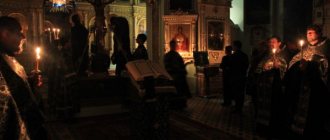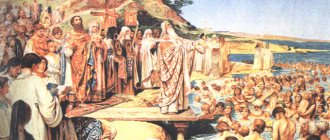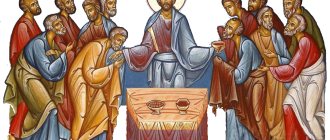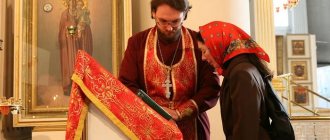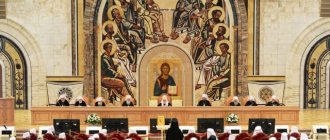Today the Royal Doors are an obligatory part of the iconostasis of an Orthodox church. They are located in the center of the iconostasis and are the main entrance to the altar. However, until about the 8th century there were no iconostases in churches, and the concept of “Royal Doors” appeared already in the 4th century. Why these gates are “Royal” and what their significance is explained by the senior lecturer of the Department of Liturgics of PSTGU Alexander TKACHENKO and the chief architect of the Association of Restorers, corresponding member of the Academy of Architectural Heritage Andrey ANISIMOV.
What are the Royal Doors?
Royal Doors
called the central doors of the Orthodox iconostasis, located opposite the throne.
They are always made with double doors and, as a rule, are decorated with icons. There is usually a small opening above the royal doors. He helps ensure that the words of the prayers pronounced at the altar are heard in the temple. At certain points in the service, this opening is covered with a curtain of fabric called catapetasma
.
Temple and its structure
The narthex is the western part of the temple. To enter it, you need to climb the steps to an elevated platform - the porch .
In ancient times, the catechumens stood in the vestibule (this is the name given to those preparing to receive baptism). In later times, the vestibule became the place where, according to the rules, the betrothal, the lithium during the all-night vigil, the rite of announcement, and the prayer of women in labor are read on the fortieth day. The narthex is also called the meal, since in ancient times love suppers were held in this part, and later meals after the liturgy. From the vestibule, a passage leads to the middle part , where worshipers are located during services.
The altar is usually separated from the middle part of the temple by an iconostasis . The iconostasis consists of many icons. To the right of the royal doors is the icon of the Savior , to the left is the Mother of God . To the right of the image of the Savior there is usually a temple icon , that is, an icon of the holiday or saint to whom the temple is dedicated. On the side doors of the iconostasis are depicted the Archangels, or the first deacons Stephen and Philip, or the high priest Aaron and Moses. of the Last Supper is placed above the royal doors . The complete iconostasis has five rows. The first is called local: in addition to the icons of the Savior and the Mother of God, it usually contains a temple icon and locally revered images. Above the local one there is a festive row of icons: icons of the main church holidays are placed here. The next row is called deisis, which means “prayer.” In its center is the icon of the Savior Almighty, to the right of it is the image of the Mother of God, to the left is the Prophet, Forerunner and Baptist John. They are depicted facing the Savior, standing before Him in prayer (hence the name of the series). The images of the Mother of God and the Forerunner are followed by icons of the holy apostles (therefore, another name for this series is apostolic). Saints and Archangels are sometimes depicted in the deisis. In the fourth row there are icons of the holy prophets , in the fifth - the holy forefathers , that is, the ancestors of the Savior according to the flesh. The iconostasis is crowned with a cross.
The iconostasis is an image of the fullness of the Kingdom of Heaven; the Mother of God, the Heavenly Powers and all the saints stand at the Throne of God.
The altar is a special, holy, important place. The altar is the holy of holies of an Orthodox church. There is a throne on which the Sacrament of Holy Communion is performed.
The altar is an image of the Kingdom of Heaven, a mountainous, sublime place. There are usually three doors leading to the altar. The central ones are called the royal doors . They are opened in special, most important and solemn places of service: for example, when the priest brings out the chalice with the Holy Gifts through the royal doors, in which the King of Glory, the Lord Himself, is present. There are side doors on the left and right of the altar barrier. deacons , most often pass through them during services .
Altar is translated as an elevated altar. And indeed the altar is located higher than the middle part of the temple. The main part of the altar is the Throne , on which the Bloodless Sacrifice is performed during the Divine Liturgy. This sacred action is also called the Eucharist, or the Sacrament of Communion. We'll talk about it later.
Inside the throne are the relics of saints, for in ancient times, in the first centuries, Christians celebrated the Eucharist at the tombs of holy martyrs [2]. On the throne there is an antimension - a silk cloth on which the position of the Savior in the tomb is depicted. Antimins translated from Greek means instead of a throne, since it also contains a piece of holy relics and the Eucharist is celebrated on it. At the antimension, in some exceptional cases (for example, during a military campaign), the Sacrament of Communion can be performed when there is no throne. On the throne stands a tabernacle , usually made in the form of a temple. It contains spare Holy Gifts for giving communion to the sick at home and in the hospital. Also on the throne is the monstrance , in which the priests carry the Holy Gifts when they go to give communion to the sick. On the throne is the Gospel (it is read during the service) and the cross . Immediately behind the throne there is a seven-branched candlestick - a large candlestick with seven lamps. The seven-branched candlestick was still in the Old Testament temple.
Behind the throne on the eastern side is a high place , which symbolically marks the heavenly throne or the chair of the eternal High Priest - Jesus Christ. Therefore, an icon of the Savior is placed on the wall above the high place. On the high place there is usually an altarpiece of the Mother of God and a large cross . They are used to wear during religious processions.
Features of use
Only clergy have the right to pass through the Royal Doors and only at strictly defined moments during the service.
The Royal Doors open
from the inside. The priest can do this standing opposite the throne, and the altar servers (sacristans) can only do this while standing on the sides of the gate.
In normal times, the Royal Doors are open only at certain points during the service. But on Easter and then during Holy Week they remain open around the clock. At the end of this period, the Royal Doors are closed before the All-Night Vigil on St. Thomas Sunday (the evening of the Saturday following Easter).
Historical and symbolic
When large church communities broke up into many parishes, the custom of waiting for a bishop disappeared. Priests began to serve in parish churches and could be in the altar from the beginning of the service. “Therefore, gradually (after the 8th - 9th centuries) the bishop’s entrance into the temple, and then into the altar, received a new meaning: additional chants and prayers appeared that accompany this entrance (today it is called the Small or entrance with the Gospel). In ancient times, the Gospel was kept in a guarded and secret place. This was due to persecution and the danger of losing the Gospel Code. Bringing the Gospel for reading was a solemn moment. Now the Gospel is always kept on the Throne, and the Small Entrance connects both actions: the entry of the bishop (priest) into the temple and the bringing of the Gospel, which is taken from the Throne, carried out through the deacon’s gate and taken back through the Royal Gate.” The meaning of the Small Entrance is interpreted differently: according to the interpretations of some holy fathers, the Small Entrance symbolizes the Incarnation and the coming of the Savior into the world, according to others - the beginning of His public ministry and going out to preach. Once again during the liturgy, a procession of clergy passes through the Royal Doors, when the Cherubic Hymn is sung and the Cup of wine, which will become the Blood of Christ, and the paten with the Lamb, which will become the Body of Christ, are brought out. This procession was called the Great Entrance. “The very first explanation of the Great Entrance dates back to the turn of the 4th - 5th centuries,” explains Alexander Tkachenko. —The authors of this time say that the procession signifies the carrying of the deceased Body of Christ taken from the Cross and His position in the tomb. After the Eucharistic prayers are read and the Gifts become the Body of Christ, they will signify the Resurrection of Christ, Christ will rise in the Holy Gifts. In the Byzantine tradition, the Great Entrance received a different interpretation. It is revealed in the Cherubic song that accompanies the procession. She tells us that the Great Entrance is a meeting of Christ the King, who is accompanied by Bodyguard Angels. And the Royal Doors can be called that not only because in ancient times the emperor entered through them, but because now Christ enters through them as the King of Glory, who goes to die on the cross for the sins of people out of love for man.”
Manufacturing options
As a rule, the Royal Doors are high enough to hide what is happening in the altar from the eyes of people in the temple. This corresponds to the tradition, which, according to legend, was introduced by St. Basil the Great
in the 4th century A.D.
Nowadays, churches are increasingly making low
iconostases
or iconostases with the Royal Doors so low that through them you can clearly see the Holy of Holies. Supporters of such church decoration refer to the experience of the early Christian Church and believe that by seeing what is happening in the altar, believers will be able to more fully participate in the divine service. Their opponents fear the loss of reverence and the desacralization of the Sacraments in the minds of the laity.
The history of the appearance of the altar in Orthodox churches
The history of the appearance of the Christian altar began at the time of the birth of Christianity. It was in early Christian times that in underground churches and basilicas stone tombs with the relics of holy martyrs were placed in front, which were fenced off. The Sacrament of the Eucharist was performed there. Even in ancient times, altars were placed on a small elevation to show their special importance and deep symbolic meaning, because it is a symbol of the Throne of the Lord.
At all times, Christians have attached to the altar the significance of the upper room in which the Last Supper was celebrated, so it is always beautifully decorated, it is always clean and beautiful. In Orthodox service books, you can often see that the altar is called the sanctuary, and this name comes from the fact that even in the Old Testament the teachers of the Church called this place the Holy of Holies. Indeed, this name emphasizes the special importance and holiness of this place, since it is there that the Holy Gifts are kept and the Sacrament of the Eucharist takes place.
( 10 ratings, average: 4.60 out of 5)
Design features and symbolism
The Royal Doors mark the gates of Heaven. Therefore, they usually become the most lavishly decorated part of the iconostasis.
evangelists are usually placed on the Royal Doors
- the apostles who wrote the Gospels. All of them are usually depicted with scrolls or books - their works. This emphasizes that the Word of God, brought to people through the preaching of the Gospel, has become the gates of salvation for us.
Also on the Royal Doors you can usually see the image of the Annunciation. He recalls that the consent of the Most Pure Virgin to become the Mother of God became “the main principle (beginning) of our salvation”: the Redeemer, the God-man Christ,
.
In Byzantium and Ancient Russia, the Old Testament Moses and Aaron
, as well as Saints
Basil the Great
and
John Chrysostom
- that is, the founders of Old and New Testament worship.
Gate for the king
“The first Christians gathered for prayer in private homes, and in the 4th century, when Christianity became the state religion, the emperors transferred basilicas to Christians - the largest buildings in Roman cities, used for court hearings and trade. The main gates in these buildings were called “royal”, through which the emperor or bishop entered the temple, explains Alexander Tkachenko. “The people entered the temple through the doors located along the perimeter of the basilica.” In the ancient Church, the main person performing divine services, as well as the head of the community, was the bishop. The service did not begin without the bishop - everyone was waiting for him in front of the church. The entrance into the temple of the bishop and the emperor, and after them of the entire people, was the most solemn moment at the beginning of the Liturgy. The altar part of the temple did not take shape right away. At first it was separated from the main part by low partitions, then in some churches curtains appeared (katapetasmas from the Greek katapštasma), which were closed at certain moments of the liturgy, primarily during the consecration of the Gifts. “There is very little evidence of these veils in the first millennium,” says Alexander Tkachenko. — The life of St. Basil the Great tells that the saint introduced the use of curtains covering the Throne for reasons that were not at all theological: the deacon who served him often looked back at the women standing in the church. In the second millennium, the use of veils became widespread. They were often decorated with embroidery, images of saints, and the Mother of God.” The name “Royal Doors” was transferred from the main entrance to the temple to the gates of the iconostasis also in the second millennium. “For the first time, the gates leading to the altar began to be given independent significance only in the 11th century,” says Alexander Tkachenko, “when one of the interpretations of the liturgy says that with the words “Doors! Doors!” It is not the gates of the temple that are closed, but the doors leading to the altar. The complete iconostasis as we know it - with the Royal Doors, rows of icons - was formed only in the 16th - 15th centuries.”
